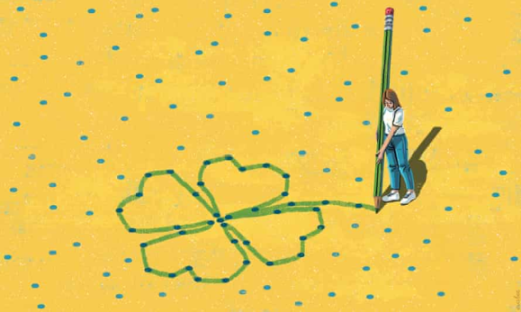To illustrate the power of the six composition tools—
definition,
restatement,
example,
comparison,
contrast, and
cause and effect—let’s do a little expository piece on “serendipity.” I’ve done some research on the word specifically for this piece, and simply as a framework, we will use this topic sentence: “Serendipity has shaped the life of the schoolteacher’s son more than he will admit.” I hope that this will be intriguing enough to make you follow the brief process that we are now about to undertake.
The first thing we need to do is establish the overall context and tone for the piece. Let’s not make it purely technical but with a little literary touch: “He had exhaustively researched the word since the scholarly young woman who was not to become his wife whispered to him at the library: “This meeting is pure serendipity, Gabriel; if not for our scholarships, you would be back in your hometown farming, and I would be preaching my faith in some backwater village.”
IMAGE CREDIT: THINK.ORG/INSIGHTS Now we will give some straightforward definitions: “
Serendipity. ‘The gift for finding without seeking.’ He later learned that the English novelist Horace Walpole coined it in 1754 to mean ‘the combination of accident and sagacity in recognizing the significance of a discovery.’” Then let’s add a little restatement for texture: “Its root was the word
Serendip, the ancient name of Ceylon, now modern-day Sri Lanka. Since then, the word had developed a strong affinity to major scientific discoveries resulting from anomaly, error, or chance.”
Our next task is to make the idea truly concrete in the reader’s mind. We will do this by giving specific examples of serendipity: “Like Henri Becquerel discovering radioactivity after unwittingly tossing a dash of uranium salt into a drawer with unexposed photographic plates. Or Alexander Fleming discovering penicillin after a certain mold accidentally contaminated his staphylococcus culture and destroyed it.”
This time let’s use comparison and contrast to capture the character of the serendipitous relationship between the schoolteacher’s son and his fiancée: “In the same token
(comparison and contrast with Becquerel’s, Fleming’s experience), but against serendipity’s supposed beneficence, the schoolteacher’s son began to see that the match between him and his fiancée was seriously anomalous. They were physically and intellectually compatible, an eminently attractive pair on campus
(comparison). But he was revolted by her later proneness to apocalyptic religious rantings... It was a slow death for him
(cause and effect).”
Now let’s assemble the whole piece, put some finishing touches, and add a suitable ending:
Serendipity has shaped the life of the schoolteacher’s son more than he will admit. He had exhaustively researched the word since the scholarly teacher who was not to become his wife told him at the library: “This meeting is pure serendipity, Gabriel; if not for our scholarships, you would be back in your hometown farming, and I would be preaching my faith in some backwater village.” At the time the word was so strange to him. Serendipity. “The gift for finding without seeking,” his desk dictionary said. He later learned that the English novelist Horace Walpole—inspired by an ancient tale about three princes who correctly described a missing camel they had never seen as “blind in one eye, missing a tooth, and lame”—coined it in 1754 to mean “the combination of accident and sagacity in recognizing the significance of a discovery.” Its root was the word Serendip, the ancient name of Ceylon, now modern-day Sri Lanka.
Since then, the word had developed a strong affinity to major scientific discoveries resulting from anomaly, error, or chance. Like Henri Becquerel discovering radioactivity after unwittingly tossing a dash of uranium salt into a drawer with unexposed photographic plates. Or Alexander Fleming discovering penicillin after a certain mold accidentally contaminated his staphylococcus culture and destroyed it. In the same token, but against serendipity’s supposed beneficence, the schoolteacher’s son began to see that the match between him and his fiancée was seriously anomalous. They were physically and intellectually compatible, an eminently attractive pair on campus. But he was revolted by her later proneness to apocalyptic rantings, by her threats of a horrible afterlife in fire and brimstone for the slightest kiss or touch before wedlock. It was a slow death for him.
Now, a few weeks before his wedding to the scholarly teacher who had introduced the word to him, he wished deeply that serendipity would work again to find a way out for him. Browsing at the local bookstore while waiting for his fiancée to come out of evening class, he just happened to glance at a tall, enigmatic woman in blue jeans picking a book not far from him. He smiled at her, and she smiled weakly back. He had never seen her before, but he had a sudden inexplicable vision that it was she and not his fiancée who would be the mother to his children.

Our little experiment in exposition is now complete.
This essay first appeared in my English-usage column in The Manila Times
in 2003 and subsequently formed part of my book English Plain and Simple: No-Nonsense Ways to Learn Today’s Global Language
, © 2004 by Jose A. Carillo, Copyright 2008 by the Manila Times Publishing Corp. All rights reserved.